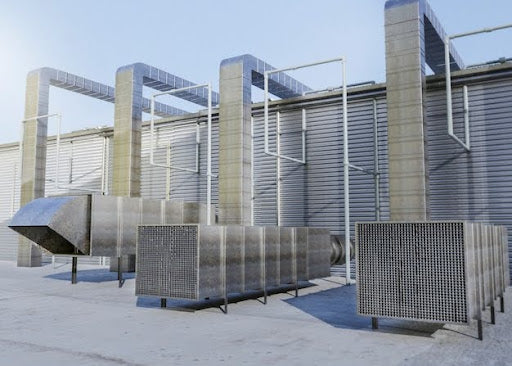Choosing the right type of ductwork can significantly impact your HVAC system’s performance and efficiency. Among the most common options are metal ductwork and flexible ducts, each with unique advantages and limitations.
In this article, we’ll break down the differences between the two, compare their pros and cons, and help you decide which option is best for your home or commercial space.
What is Metal Ductwork
Metal ductwork is a type of HVAC duct system made from rigid sheet metal, typically galvanized steel or aluminum. It’s known for its strength, durability, and ability to maintain consistent airflow over long distances. Because of its solid construction, metal ductwork is less likely to sag or collapse, making it ideal for permanent installations in both residential and commercial buildings.
Metal ducts are often preferred for their long lifespan, resistance to mold and pests, and ease of cleaning. However, due to their weight and the need for precise measurements and fittings, they usually require professional installation.
What are Flexible Ducts
Flexible ducts are a type of HVAC ductwork made from a plastic inner core wrapped in insulation and covered with a protective outer layer, often made of foil. They are lightweight, easy to install, and can bend around obstacles, making them ideal for tight or awkward spaces where rigid metal ducts would be difficult to fit.
Flexible ducts are commonly used in residential HVAC systems due to their affordability and convenience. However, they are more prone to kinks, sagging, and airflow resistance if not installed properly. Regular inspection and careful handling are key to maintaining their performance over time.
Pros and Cons of Metal Ductwork
Metal ductwork is a popular choice in both residential and commercial HVAC systems due to its strength and long-term performance. However, like any material, it comes with its own set of benefits and limitations. Here's a closer look at the pros and cons:
Pros of Metal Ductwork
-
Durability
Built from galvanized steel or aluminum, metal ducts are highly durable and resistant to wear, pests, and extreme temperatures. -
Airflow Efficiency
The smooth interior surface allows for optimal airflow, reducing friction and energy loss. -
Easy to Clean
Metal ducts are easier to clean and less likely to harbour mold or contaminants.
Cons of Metal Ductwork
-
Higher Cost
Metal duct systems tend to be more expensive to purchase and install. -
Rigid Installation
Their inflexibility makes them harder to work with in tight or irregular spaces. -
Labor-Intensive Setup
Proper installation often requires professional tools and experienced technicians.
Pros and Cons of Flexible Ducts
Flexible ducts offer a lightweight and convenient alternative to traditional metal ductwork. While they’re easier to work with, they may not always match the durability or performance of metal options. Below are the main pros and cons to consider:
Pros of Flexible Ducts
-
Easy Installation
Their lightweight, bendable design makes them ideal for quick installations in compact or complex layouts. -
Cost-Effective
Flexible ducts are typically more affordable in terms of both materials and labour. -
Versatile Fit
They can be routed around obstacles with minimal fittings, saving time and effort.
Cons of Flexible Ducts
-
Prone to Damage
The soft material can be crushed or torn easily, affecting performance. -
Reduced Airflow
The ribbed interior can slow airflow and increase energy consumption. -
Maintenance Challenges
More difficult to inspect and clean, which can lead to dust buildup or mold if not properly installed and maintained.
Which one is Better
Choosing between metal ductwork and flexible ducts isn’t always straightforward. The right option depends on your specific project requirements, space constraints, and budget. To help you decide, here are a few key factors to consider when comparing the two:
Installation Space
If you’re working in a tight or irregular area, flexible ducts are usually the better choice. Their bendable design makes them easy to route through obstacles without needing extra joints or fittings. Metal ductwork, while sturdy, requires more space and a precise layout.
Airflow Efficiency
Metal ductwork wins when it comes to airflow. The smooth interior surface reduces resistance, helping your HVAC system run more efficiently. Flexible ducts, especially if not installed correctly, can restrict airflow if they sag or become kinked.
Cost and Labour
For those on a tighter budget, flexible ducts offer a more affordable solution with lower material and installation costs. Metal ducts are more expensive and usually require professional installation, but they offer longer-term value in return.
Durability and Maintenance
Metal ductwork is better suited for long-term durability and ease of cleaning. It's less prone to physical damage and can last for decades. Flexible ducts can wear out faster, especially if they are frequently adjusted or compressed.
Choose metal ductwork if you want maximum efficiency and long-term durability, and have the budget and space for a more permanent installation.
Opt for flexible ducts if you're looking for a quick, budget-friendly solution that can easily adapt to tight or complex spaces.
Shop High-Quality Flexible Ducts at Voomi Supply
In the end, the choice between metal ductwork and flexible ducts depends on your specific needs, budget, and installation space. Metal ducts offer durability and long-term performance, while flexible ducts provide easier installation and cost savings.
For many residential and light commercial applications, flexible ducts strike a great balance between efficiency and convenience. If you're looking for reliable, high-quality flexible duct options, check out the flex duct collection at Voomi Supply to find the right fit for your HVAC system.


